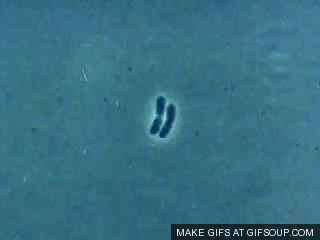
Bacteria
A 12 min. Crashcourse video on bacteria
Prokaryotes are thought to be the first organisms to appear on Earth. This makes perfect sense since prokaryotes are much simpler than eukaryotes. Prokaryotes, such as bacteria, survive in environments inhospitable to eukaryotes. Since the early Earth was extremely dangerous with many meteors and asteroids bombarding the Earth, eukaryotic cells could not have survived. Prokaryotes have three main types of shapes. They are cocci (spherical), bacilli (rod-like), and spiralia (spiral). Two examples of bacteria are E Coli, and MRSA, an example of antibiotic-resistant bacteria. These bacteria are often very harmful to humans.
Prokaryotes have three layers surrounding the cytoplasm. The innermost layer is a plasma membrane. This plasma membrane is nearly identical to that of the cell membrane of eukaryotes. The next layer is the cell wall. The cell wall of a prokaryote is different than that of eukaryotes. The cell wall of prokaryotes is constructed from peptidoglycan, a carbohydrate. The final and outermost layer is the capsule. The capsule of a prokaryote, which is made of polysaccharides or proteins, allows the prokaryotes to stick to other cells or substances. The genetic information used in bacteria are plasmids, which you already learned about. If you forgot, plasmids are small circles are DNA or RNA.
The amount of peptidoglycan in a cell wall is very important. Cells with more peptidoglycan are often less dangerous than that with low amounts of peptidoglycan in their cell wall. There is a test called a Gram Stain that identifies whether or not the cell wall of a prokaryote has a high or low level of peptidoglycan. Gram-positive bacteria will often have high amounts of peptidoglycan, while gram-negative bacteria have low levels of peptidoglycan. This is significant since the analysis of the peptidoglycan in bacteria may lead to the correct antibiotic used.
Prokaryotes have methods of movement as well. The main method for prokaryotes is the flagella, a long tail on the prokaryote. The prokaryote moves by whipping its tail back and forth to move. Pili, or cilia, are small hairs on a prokaryote to aid with movement. Most prokaryotes follow taxis, or movement because of a stimulus.
Prokaryotes benefit humans in many ways. Prokaryotes decompose cells, guard against pathogenic organisms, and supply vitamins. Only a very small percentage of bacteria harm the human body.
There are four different ways in which bacteria obtain energy. the first is photoautotrophs, which obtain energy from photons(light) and obtain carbon from CO2. Photoheterotrophs obtain energy from photons, and obtain carbon from organic molecules. Chemoautotrophs obtain energy from the break-up of chemicals, and obtain carbon from CO2. Finally, chemoheterotrophs obtain energy and carbon from organic molecules.
 |  |
|---|---|
 |  |
A bacteria multiplying


Bacilli Bacteria
By. Derek Hu